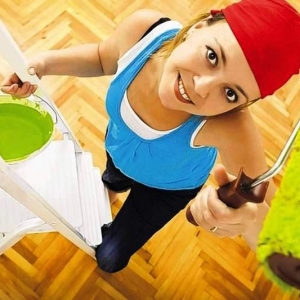More recently, tile and decorative tiles were used to repair in the bathroom. Today, instead of these traditional finishing materials, moisture-resistant paints are increasingly used. In comparison with ceramics, they are relatively inexpensive, and the colorful colorful palette color variety allows you to successfully implement the most courageous design ideas and dreams.
Choose the paint for the bathroom
In the modern market of building materials, paint products are presented in a huge assortment. However, when choosing paint for the bathroom, consider that this room is most often distinguished by high levels of humidity. That is why latex and acrylate paints or alkyd enamel are ideal for staining of the walls of the bathroom. They are comfortable in applying, practical in operation and, most importantly, resistant to moisture and temperature fluctuations.
Preparation for finishing work
Before starting finishing work in the bathroom, you need to properly prepare walls under painting:
- First of all, the previous facing / paints and varnishes are removed from the working surfaces. For the removal of old paint, special solvents are used to dismantle the ceramic tiles are used a corner-melting machine. Dust from purified surfaces is removed with a damp cloth.
- The next stage of work is putty. To eliminate high drops and eliminate coarse defects (chips, cracks and cracks), it is better to use the starting putty, and for finishing finish - the finish. After complete grazing, the sheplicated areas are carefully cleaned with fine-grained emery.
- Then proceed to priming - the processing of walls by moisture-resistant primer. This procedure helps to improve the adhesion (adhesion) of the paintwork with the treated surface and prevents the formation of divorces and flows. The primer must be applied at least 2 layers.
- After drying, the walls of the wall twice are coated with an antiseptic solution, which includes antibacterial substances in the component composition. This impregnation will help to avoid the appearance of malicious molds, bacteria and fungi.
- At the end of the preparatory work, the bathroom is carried out within 24-48 hours (depending on the level of humidity in the room) and only after that begin to staining the walls.

Bathroom Staining Tool
For painting of walls and the ceiling of the bathroom, you can use various "tools of labor" - pulverizers, fur rollers and brushes. Sprayers are used for monotonous staining of surfaces and creating smooth decorative transitions in the premises of a large area. In case of painting works in compact bathrooms, it is advisable to use brushes and rollers. Brushes are indispensable when painting hard-to-reach areas, angles and joints, as well as when applying clear design drawings. Painting rollers are the most suitable inventory for fast and uniform painting of smooth surfaces. For an economical kit and removal of its excess from the roller, a special tray-cuvette is used.
Tips on painting bathroom
Getting Started with the direct painting of the bathroom, consider the following recommendations:
- before applying the paint, mix thoroughly with a clean plastic or a wooden stick to a homogeneous state;
- the walls of the walls cover at least two layers of paint - the first layer creates the main background, the second is a deep finishing shade;
- if the use of paints of different shades is envisaged, be sure to use greasy tape for separating color boundaries.
An important nuance! The painted parts of the walls on which water splashes fall daily is recommended to be covered with panels from transparent plastic or glass.
Screening paint
To make the interior of the bathroom more sophisticated and creative, resort to stencil staining of the walls. Ready stencils for applying decorative drawings can be purchased at building materials stores. However, in the presence of free time and desire to create uncomplicated original patterns, you can make it yourself. For making stencils, dense cardboard, vinyl film or thin plastic will be used.
Staining walls is the perfect opportunity quickly, efficiently and accessively changing the usual appearance of the bathroom.



































